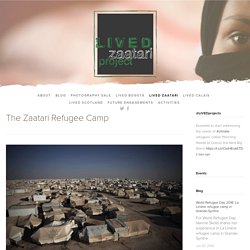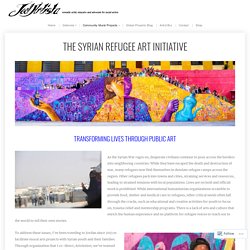

Jordan: Malala Visits Za'atari Refugee Camp. A Day in the Life: Za'atari - Episode 12: The human touch. A Day in the Life: Za'atari - Episode 11: Just another day. A Day in the Life: Za'atari - Episode 8: Coping mechanisms. A Day in the Life: Za'atari - Episode 7: The trouble with kids. A Day in the Life: Za'atari - Episode 2: Theft or privatization? A Day in the Life: Za'atari - Episode 1: Welcome to Za'atari. Ft. Premium Digital All the benefits of Standard Digital, plus: Unlimited access to all content Instant Insights column for comment and analysis as news unfolds FT Confidential Research - in-depth China and Southeast Asia analysis ePaper - the digital replica of the printed newspaper Full access to LEX - our agenda setting daily commentary Exclusive emails, including a weekly email from our Editor, Lionel Barber Full access to EM Squared- news and analysis service on emerging markets Standard Digital Access to FT award winning news on desktop, mobile and tablet Personalised email briefings by industry, journalist or sector Portfolio tools to help manage your investments FastFT - market-moving news and views, 24 hours a day Brexit Briefing - Your essential guide to the impact of the UK-EU split.

Sandcastles bring happiness to Syrian kids. Photo: Sumaya Agha/Mercy Corps Photo: Sumaya Agha/Mercy Corps Photo: Sumaya Agha/Mercy Corps Photo: Sumaya Agha/Mercy Corps Photo: Sumaya Agha/Mercy Corps Photo: Sumaya Agha/Mercy Corps Photo: Sumaya Agha/Mercy Corps Photo: Sumaya Agha/Mercy Corps Photo: Sumaya Agha/Mercy Corps Photo: Sumaya Agha/Mercy Corps Last spring, one of the children’s facilities we've built at Jordan's Zaatari refugee camp was set to be covered with concrete when Mercy Corps Project Manager Hazem Salman had the idea to put the desert sand to creative use in the hands of the children.

Five stories of hope from Zaatari refugee camp. Half of the 30,000 Syrian school-aged children in the camp are out of school.

Four children and a teacher share how UNESCO’s project has given them new hope. The project is funded by the European Union and implemented in partnership with War Child UK. Ayad, 11, learning to make friends again Eyad watched two of his friends get shot and die in Syria, the final straw for his father who decided to move his family to Jordan. The event left him anxious and aggressive and unable to study. 7 art initiatives that are transforming the lives of refugees. Zaatari Documentary — LIVED. Uprooted from their homeland in Syria and seeking "temporary" shelter in Jordan, the hope of displaced Syrian youth flourishes behind stories of grief and loss, but also of resiliency and humour.

The personal and spontaneous stories recounted by youth in Learning to Swim shed light on the relationships, aspirations, challenges and determination of their day-to-day lives. Learning to Swim is the first documentary produced by LIVED as part of the ongoing Lived Zaatari Documentary Project. Filmed in May 2014, the documentary seeks to shed light on the everyday lived experiences of displaced Syrian youth in the Zaatari Refugee Camp, the village of Zaatari nearby, and Amman in Jordan.
The Zaatari Refugee Camp — LIVED. As an attempt to have the camp organized as a city, Zaatari was divided into 12 districts, with representatives chosen from each district.

Leadership in the camp remains an issue with the presence of gang leaders, which is why UNHCR is hoping to have traditional Syrian leaders who were previously involved in their communities stepping up as positive leaders in the districts. The oldest part of the camp, Districts 1 and 2, is surnamed the ‘Old City’, and whilst it benefits from close access to services such as schools and hospitals, it is one of the highest densely populated area of Zaatari refugee camp.
Art with Syrian Refugees: The Za’atari Project. As the Syrian War rages on, desperate civilians continue to pour across the borders into neighboring countries.

While they have escaped the death and destruction of war, many refugees now find themselves in desolate refugee camps across the region. Other refugees pack into towns and cities, straining services and resources, leading to strained tensions with local populations. Lives are on hold and official work is prohibited. While international humanitarian organizations scramble to provide food, shelter and medical care to refugees, other critical needs often fall through the cracks, such as educational and creative activities for youth to focus on, trauma relief and mentorship programs. FACTSHEET ZaatariRefugeeCamp October (1) Syria Regional Refugee Response - Jordan - Mafraq Governorate - Zaatari Refugee Camp. Zaatari refugee camp: Rebuilding lives in the desert. 3 September 2013Last updated at 06:12 Two million people have fled over Syria's borders to escape the bloody internal battle engulfing the country, the latest UN figures show.

One million of them are children. Many of those forced to leave their homes have taken refuge in neighbouring countries, but 130,000 of them are now living in a three-square-mile piece of the desolate Jordanian desert - home to the sprawling Zaatari refugee camp. Joint Education Needs Assessment 2014 E copy2. Inside Zaatari refugee camp: the fourth largest city in Jordan. Indeed, Zaatari’s basic structure was constructed in just nine days and was initially home to just 100 families, but after exponential growth it is now home to 81,000 inhabitants, all living within its five-mile circumference.

Since the civil war began, approximately half of the country's 22 million population has been displaced. High cases of rape and young marriage Due to the unplanned nature of the camp’s growth, administrators have found it particularly challenging to manage; people can move their tents and caravans and services are unevenly distributed across its vast expanse. The Women of Zaatari Refugee Camp. The older, more established parts of the camp are generally safer because they have electricity.

People know or are related to one another, unlike in the newer areas, where neighbors are strangers. Those outlying areas are much less crowded, trailers and tents are more widely spaced, and there are no streetlights, making a nighttime visit to the communal toilets, for example, a terrifying dash. There is talk of rapes and prostitution, but few cases of sexual assault are reported because most victims refuse to speak out because of the social stigma attached to sexual violence. Zaatari is just one consequence of a hemorrhaging Syrian conflict that began in March 2011 with peaceful protests against President Bashar al-Assad and morphed into a grinding civil war that has claimed more than 120,000 lives. Nearly a third of Syria's population of about 23 million is now displaced. Evaluation of Child Friendly Spaces: Iraq Field Study Report. Child Friendly Spaces Research Collaboration. Child Friendly Spaces (CFS) are used by humanitarian agencies to support and protect children in emergencies.

Children are the most vulnerable group during conflict and in the aftermath of a disaster, both emotionally and physically. CFS provide young people with a safe place to play, participate in activities, learn about their rights to health and protection, and experience healing from trauma they’ve experienced. They also allow children to return to healthy routines and experience a sense of normalcy again. Child-Friendly Spaces on Flipboard. 269780134 Guidelines for Child Friendly Spaces. Child-friendly Millennium Development Goals. 28407318 Child Friendly Schools Manual. Child-Friendly Spaces - Teachers Without Borders.
The Right to Education. Education is a fundamental human right and essential for the exercise of all other human rights. It promotes individual freedom and empowerment and yields important development benefits. Yet millions of children and adults remain deprived of educational opportunities, many as a result of poverty. Normative instruments of the United Nations and UNESCO lay down international legal obligations for the right to education. These instruments promote and develop the right of every person to enjoy access to education of good quality, without discrimination or exclusion. Teachers Without Borders. WHAT’S IN MY BAG? – Uprooted – Medium. This year, nearly 100,000 men, women and children from war-torn countries in the Middle East, North Africa and South Asia have fled their homes and traveled by rubber dinghies across the Aegean Sea to Lesbos, Greece.
Refugees travel light, for their trek is as dangerous as it is arduous. They are detained, shot at, hungry.